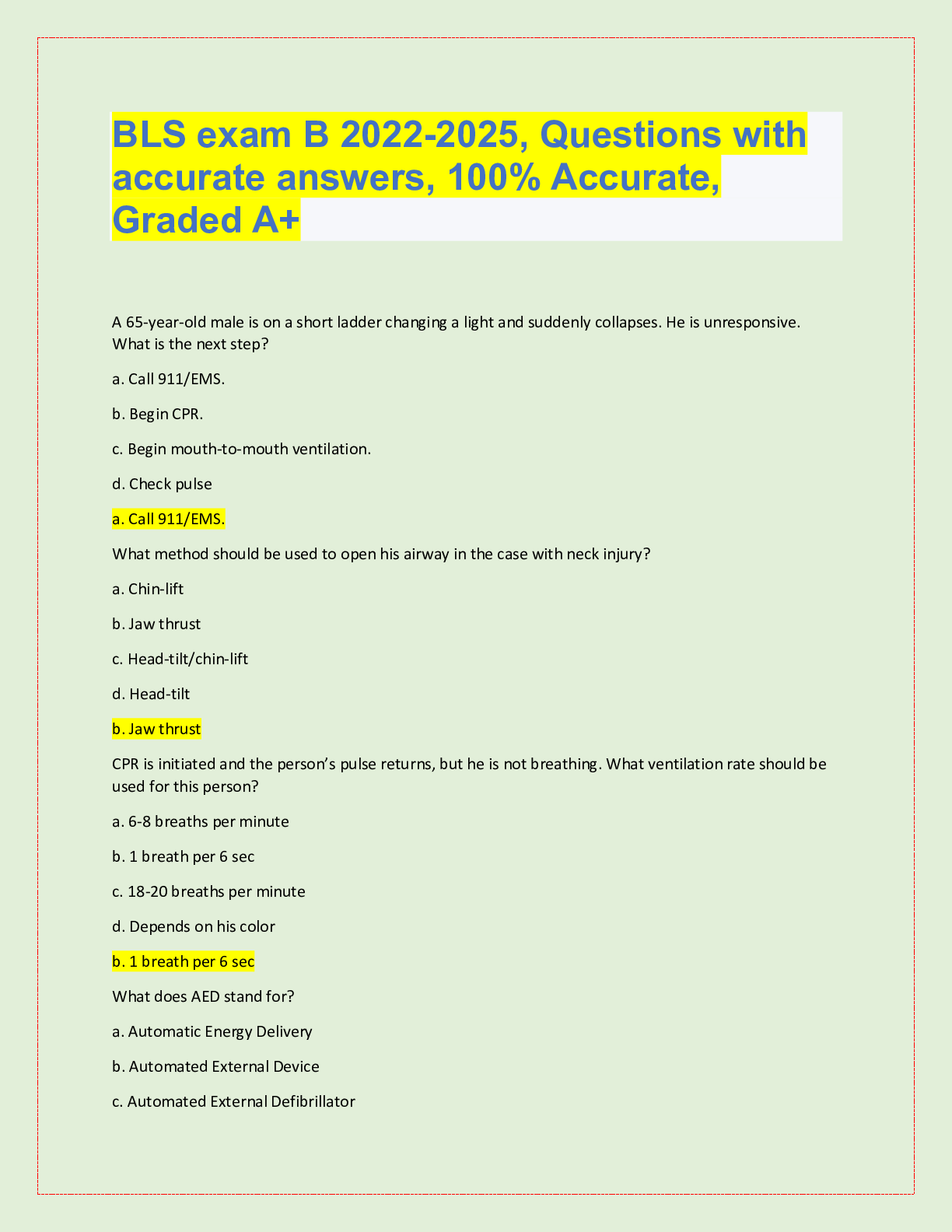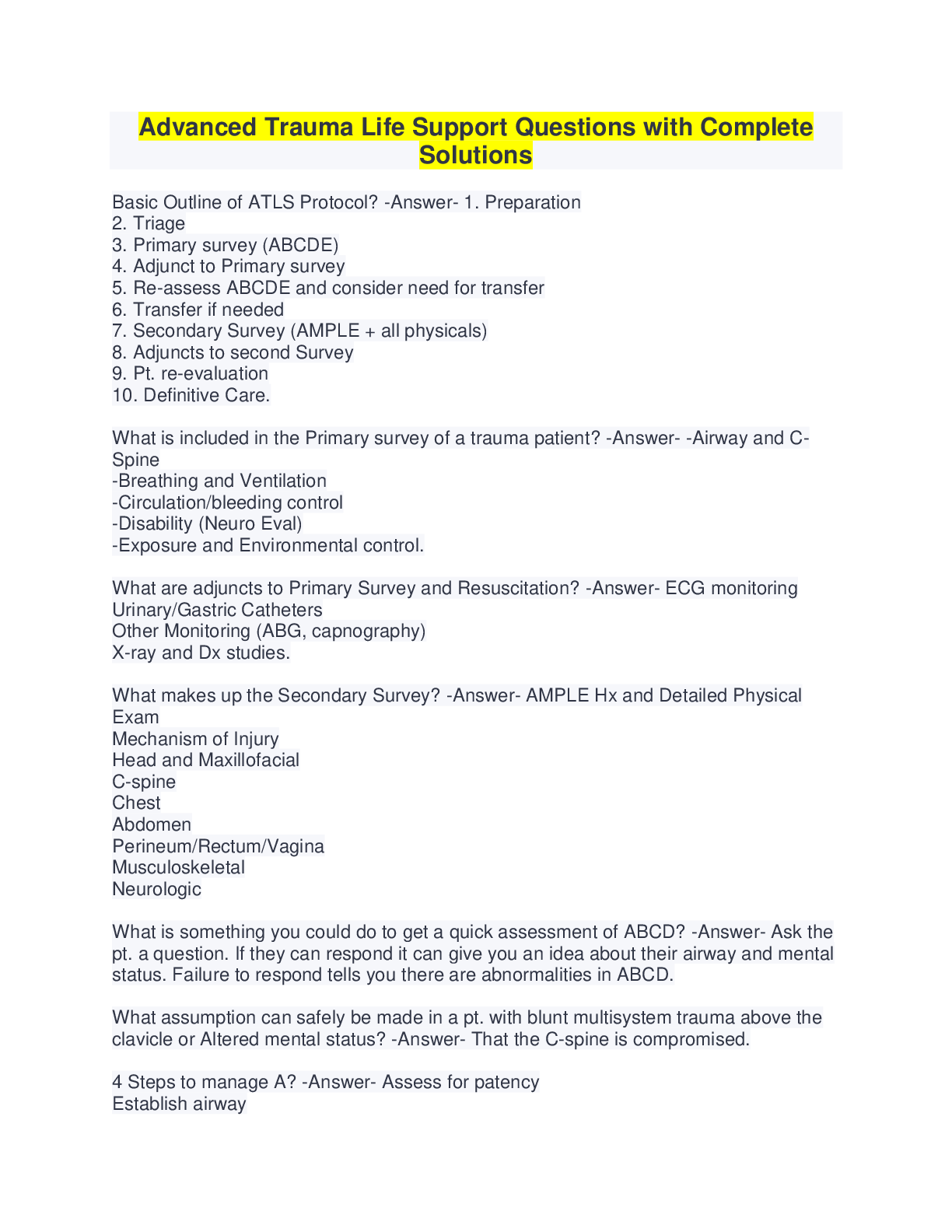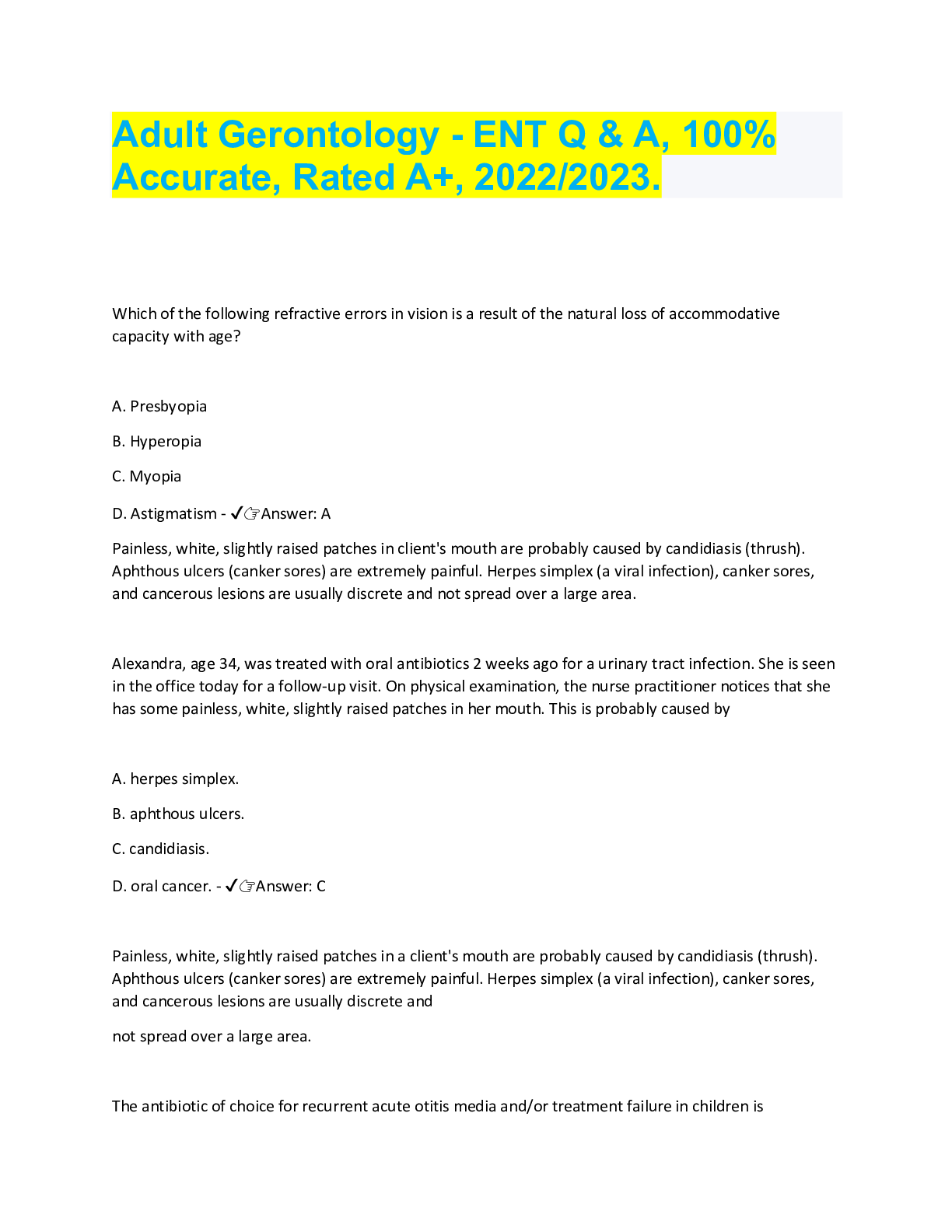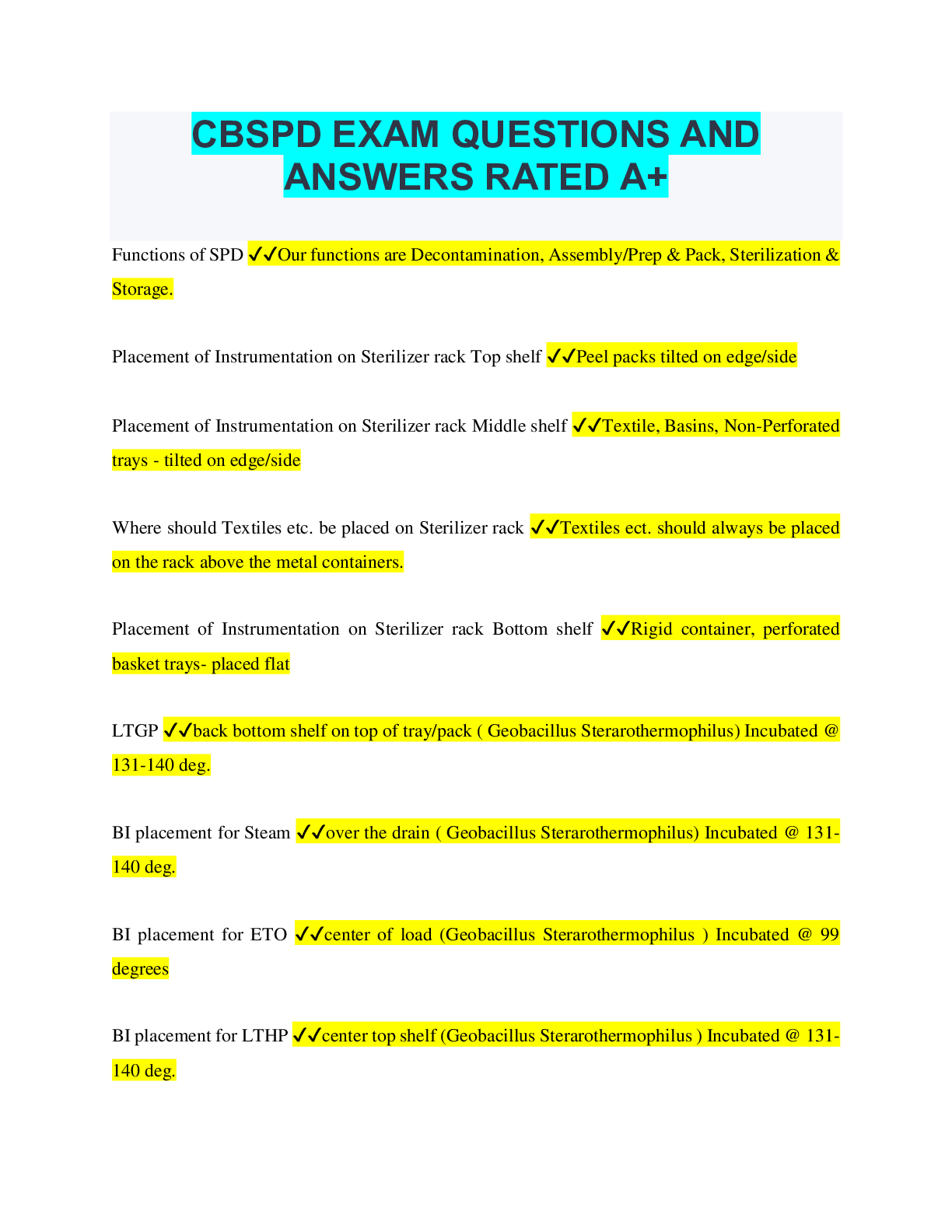Management > QUESTIONS & ANSWERS > WGU D073 Best Practices in Management: Projects, Staffing, Scheduling, and Budgeting, Complete. R (All)
WGU D073 Best Practices in Management: Projects, Staffing, Scheduling, and Budgeting, Complete. Rated A+, verified.
Document Content and Description Below
WGU D073 Best Practices in Management: Projects, Staffing, Scheduling, and Budgeting, Complete. Rated A+, verified. "Great Man" - ✔✔-A nineteenth-century theory proposed by Thomas Carlyle t... hat states that history is largely explained by the impact of great men or heroes and their superior intellect and other attributes. You are either born to be a leader or not. 360 Evaluation - ✔✔-A process through which feedback from an employee's subordinates, colleagues and supervisors as well as a self-evaluation by the employee themselves is gathered Accounts Receivable - ✔✔-Money owed to a company by its debtors Acquisitiveness - ✔✔-Excessive interest in acquiring money or material objects Affiliative - ✔✔-The need to form social or emotional bonds with others Allocation - ✔✔-To distribute or to give each person a portion of something. Assets - ✔✔-Property owned by an organization or individual; used to pay off liabilities Assumptions - ✔✔-Anything that is accepted as true or certain to happen, without proof Attributes - ✔✔-A quality or feature of something. Attrition - ✔✔-It is not to replace employees when they leave Authoritarian - ✔✔-To act in a dictatorial manner. Enforcing strict obedience. Balance sheet - ✔✔-A statement of assets, liabilities, and capital for an organization at a particular point in time Behavioral theory - ✔✔-Behavioral theory is based on the premise that behaviors are conditioned as a result of experiences with the environment; anyone can be trained to behave in a preferred way. Bias - ✔✔-A prejudice in favor or against one thing, person or group compared to another, usually in a way that is considered unfair or unjust Bottom-Up Approach - ✔✔-Starts with the employees. They are surveyed as the main users of a system to gather information on how to implement a change Business Indicators - ✔✔-Numbers that may indicate a positive or negative trend. Examples include demand for product, profit margin, revenue, professional development levels of workforce, market share, amount of debt, and deals finalized by the sales team. Business Units - ✔✔-A logical segment of a business representing a specific business function and which has its own vision, strategy, and direction Capital Assets - ✔✔-Capital assets are significant pieces of property such as buildings, cars, investment properties, stocks and bonds Cash Disbursements - ✔✔-The money paid out by an organization to settle an obligation Cash Receipts - ✔✔-The money received by an organization as payment for a good or service Central-Tendency - ✔✔-The tendency for data to move toward the mean value over time. Central tendency is also a measure of a single value that describes how data cluster around a central value. This value can be used to represent a sample. Change Management Process - ✔✔-Includes all of the processes involved to prepare, support, and lead individuals, groups, or organizations in making a change Channel richness - ✔✔-The ability of the channel to handle multiple cues at the same time, to provide rapid feedback, and to facilitate a more personal conversation Cloud Technologies - ✔✔-Any hosted services delivered over the internet. There are three broad groups of services: Infrastructure as a Service (IaaS), Platform as a Service (PaaS), and Software as a Service (SaaS) Commodity - ✔✔-A raw material or primary agricultural product that can be bought or sold. A commodity is a basic good used in commerce that is interchangeable with other basic goods Contingency Theory - ✔✔-predicts that effective leaders are those whose personal traits match the needs of the situation; a ___________ is a future event or circumstance that cannot be predicted with absolute certainty Contract employee - ✔✔-An individual retained by a company for a particular purpose, price, and time period. Since a contract worker is not an employee, the company does not provide traditional employee benefits Costs - ✔✔-Financial measure of the resources used or given up to achieve a stated purpose Culture change - ✔✔-The behavior of humans interacting in a group or organization and the meaning they assign to that behavior. It may include the company vision, values, norms, systems, symbols, language, beliefs, and habits. Culture is ingrained and therefore very difficult to change Currency exchange rate - ✔✔-The value of two currencies in relation to each other. The rate of which usually depends on supply and demand Database management - ✔✔-The system of software that is used to create, retrieve, update, and manage large amounts of data Decentralize operations - ✔✔-The daily operations decision-making responsibility are delated by top managers to middle or lower level managers. Top-level managers can then focus more on strategical planning Depreciation - ✔✔-A reduction in the value of an asset over the passage of time Differentiated / differentiation - ✔✔-A specialized product that is created to attain a competitive advantage in a specific segment of the market; Coach handbags margins are high due to the markup on each bag to cover marketing costs rather than production Dividends - ✔✔-A sum of money paid regularly by a company to its shareholders out of its profits Durable goods - ✔✔-Goods not for immediate consumption that are able to be kept for a long period of time Economies of scale / cost leadership - ✔✔-A savings in costs to produce a product due to the ability to produce it in large amounts or numbers; cost leadership pertains to a firm's ability to create economies of scale through efficient operations that produce a large volume; Walmart, McDs, P&G Effectively - ✔✔-To do something in a manner to achieve the best possible results. Efficiently - ✔✔-To do something in a way that achieves the maximum level of productivity with a minimum level of wasted expense or effort. Emergent - ✔✔-Change that is not planned. This change comes about in response to a need to change processes Encoding - ✔✔-The process of converting information into a particular form Enterprise resource planning - ✔✔-A suite of software that allows an organization to automate many of the traditional office functions especially technology, services, and human resources Entrepreneur - ✔✔-A person who owns and operates his or her own business. Equity - ✔✔-Value of a property after debt is deducted or the value of shares of stock issued by a company Financial accounting - ✔✔-A branch of accounting that uses standardized processes to prepare financial documents, such as an income statement and balance sheet, for external review and use Focus groups - ✔✔-A diverse group of people who are brought together to have a guided discussion and provide feedback regarding a plan for a new initiative or product Forecast - ✔✔-The act of predicting business activity for a future period of time Functional - ✔✔-An organizational structure where workers are grouped by skills or knowledge Furloughs - ✔✔-A temporary leave of absence. It can be used by organizations as a temporary laying off without pay to decrease expenses Gross national product - ✔✔-The total value of goods and services produced by a country in a given year Halo-effect - ✔✔-The tendency for an impression in one area to influence opinions in another area Heuristics - ✔✔-An approach to problem solving that uses a more practical method. Usually used as an aid to learning or discovery. These cognitive short-cuts can lead to biases Income statement - ✔✔-A summary of all of an organization's revenues and expenses during a predefined period of time Innate - ✔✔-Inborn. Something you are born with. Interaction model of communication - ✔✔-The interaction model is like two transmission models stacked on top of each other with feedback. The feedback is not simultaneous Inventory - ✔✔-A complete list of items such as property, goods in stock, and the contents of a building Inventory financing - ✔✔-Using inventory as a collateral for a loan if the business does not sell its products and cannot repay its loans Irrationality - ✔✔-Acting, thinking, or talking in a way that is illogical or unreasonable. Just-in-time inventory system - ✔✔-An inventory method designed to increase efficiency, decrease wastes, and cut costs by only having the inventory on hand that is currently needed to fill orders Key performance indicators - ✔✔-A measurement of how effectively a company is achieving its key business objectives Laissez-faire - ✔✔-A policy of letting things happen as they would. Not interfering. LEAN - ✔✔-An organization focused on customer value. The organization focuses its processes on incrementally increasing customer by value Learning organization - ✔✔-The business term given to a company that facilitates the learning of its members and continually transforms itself Liabilities - ✔✔-State of responsibility for something. What an organization or individual owes; may include a requirement to pay cash, transfer assets, or provide services to someone else. Managerial accounting - ✔✔-Also called cost accounting, a means of using accounting to align processes with the organization's goals. It is intended for internal use and used to provide management with important information to assist in decision-making and running the business. Market capitalization - ✔✔-The total value of a company based on the company's outstanding shares of stock multiplied by the current share price Market position - ✔✔-The customer's perception of a brand or product in relation to its competition Market segmentation - ✔✔-The process of dividing a market of potential customers into groups or segments Master budget - ✔✔-Budget composed of all the lower level budgets, financial statements, cash flow, and financial plans Matrix - ✔✔-An organizational structure in which the reporting relationships are set up in a grid instead of the more traditional hierarchy Mechanistic - ✔✔-A hierarchal organizational structure with central authority Mission statement - ✔✔-A _________________ describes the purpose of a company, its goals, and how it will achieve its vision. Supports vision Needs assessment - ✔✔-A systematic process for determining and addressing needs or gaps between the current condition and the desired future condition Net income - ✔✔-Commonly called the "bottom line," it is an individual's income after taking taxes and other deductions into account Objectives - ✔✔-A specific measurable action that must be taken to reach a goal Opportunity cost - ✔✔-The inability to pursue another alternative that offers a potential gain after making a choice Organizational Capacity for Change - ✔✔-The capability of an organization to either effectively prepare for or respond to an unpredictable competitive environment Organizational hierarchy - ✔✔-Can be made up of top managers, middle managers, first-line managers, and team leaders. Outsource - ✔✔-To obtain goods or services from an outside or foreign source Overhead - ✔✔-The necessary expenses of running a business that cannot be directly linked to a product or service People management - ✔✔-A branch of business that involves leading people, understanding employment law, motivating employees, and providing constructive feedback. People management can also be human resource management which includes recruiting new employees, management, and providing support and direction for employees after they are hired Performance metric - ✔✔-The data and figures that are obtained to measure how well an organization and its employees are performing Personality - ✔✔-The combination of characteristics or qualities that form an individual's distinctive character Portfolio - ✔✔-A range of investments or businesses held by an organization or person Production budget - ✔✔-The number of units of products that must be produced based on the sales budget and the requirements for inventory on hand Quality assurance - ✔✔-Maintaining the desired level of quality in a product or service using data or feedback to check each step in the process Raw materials - ✔✔-The basic materials from which a product is made Return on Investment (ROI) - ✔✔-The profit you receive for investing. Calculated by dividing the amount of money gained by the cost of the investment expressed as a percentage Revenues - ✔✔-The income generated from the sale of goods or services. Scope of change - ✔✔-Managing, controlling, and documenting all changes to a project's size and depth. The scope of change may range from minor local adjustments to a full corporate transformation Sensory route - ✔✔-The five senses include visual or sight, auditory or hearing, touch, taste or gustation, and olfaction or smell Six Sigma - ✔✔-A method that organizations use to increase their performance and decrease any variation in processes Sole proprietorship - ✔✔-It is the simplest business form under which one can operate a business. A single person owns the business and is responsible for its debts Speculative measures - ✔✔-A measure that results in an uncertain degree of gain or loss Strategic - ✔✔-The act of developing long-term goals and determining the best way to go about achieving them. Strategy - ✔✔-A plan of action or policy that will be followed to achieve your goal Tone of voice - ✔✔-How your message comes though, in both written and spoken form, based on the way you say it and the impression it makes Top-down change - ✔✔-The highest levels of the administration will drive the change. They will map out the process and deliver it to the staff. This method of change is fast and clear, which makes it easy to make a decision Transaction model of communication - ✔✔-The ___________ model of communication has each participant acting as a combination sender-receiver Transactional theories - ✔✔-_____________ leadership focuses on supervision, organization, and performance. Rewards and punishments are used. It works best in organizations where there are linear processes and employees know their jobs wel [Show More]
Last updated: 2 years ago
Preview 1 out of 23 pages

Buy this document to get the full access instantly
Instant Download Access after purchase
Buy NowInstant download
We Accept:

Reviews( 0 )
$12.00
Can't find what you want? Try our AI powered Search
Document information
Connected school, study & course
About the document
Uploaded On
Mar 14, 2023
Number of pages
23
Written in
Additional information
This document has been written for:
Uploaded
Mar 14, 2023
Downloads
0
Views
96
























.png)

